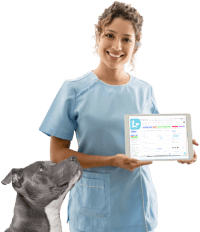- Artificial Intelligence
- Pet Care
- Team & Client Retention
- Veterinary Business
- Veterinary Practice Management
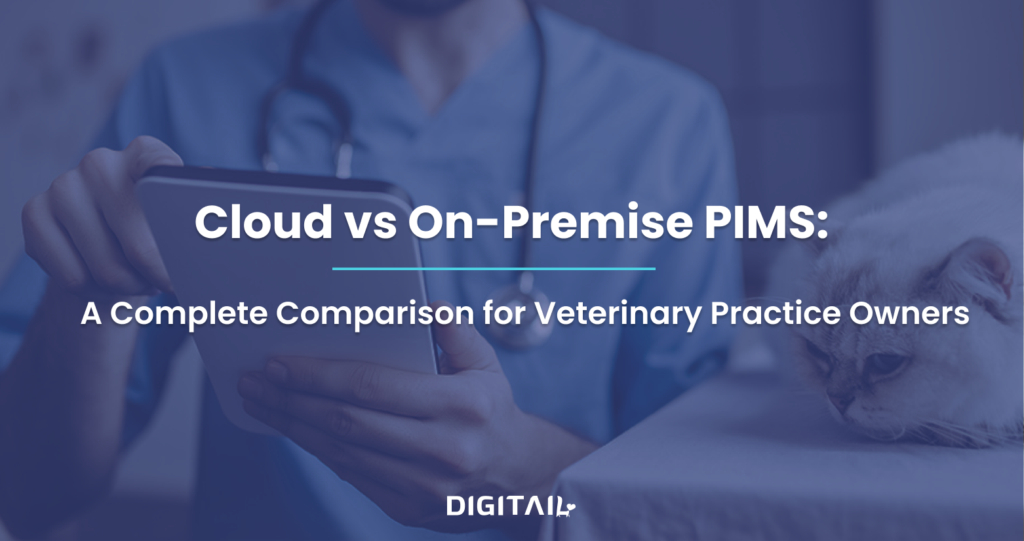
Cloud-Based vs. Server-Based Veterinary Software: A Complete Comparison for Practice Owners
Veterinarians drowning in paperwork and missing critical patient information need effective software solutions now more than ever. The right veterinary management software doesn’t just streamline daily workflows, it impacts long-term scalability and the quality of care a practice can provide.
While server-based systems were once the standard, cloud-based veterinary software is gaining traction due to its accessibility, security, and cost-efficiency.
About 70% of new veterinary software installations are cloud-based, reflecting a strong trend towards modern and adaptable cloud solutions over traditional systems.
But which solution truly fits your practice’s needs? To make an informed choice, let`s explore how each system works.
How Does Cloud-Based Veterinary Software Work?
Cloud-based veterinary software operates on a Software-as-a-Service (SaaS) model. The application and all practice data reside on remote servers maintained by the software provider.
Veterinary professionals access the system via the internet from any device – desktop, tablet, or smartphone – without needing local installations while delivering real-time synchronization across all platforms.
Key characteristics:
- Subscription-based pricing (monthly/annual fees based on practice size or user count)
- Automatic updates (no manual IT work required)
- Data is stored securely in the cloud with encrypted backups
- Real-time syncing across multiple locations
How Does Server-Based Veterinary Software Work?
Server-based veterinary software, also known as on-premise software, requires practices to purchase and maintain their own physical servers and IT infrastructure. The practice is responsible for maintaining hardware, security, and software updates.
Key characteristics:
- Large upfront cost (licenses, servers, IT setup)
- Manual updates & maintenance (IT staff or vendor support needed)
- Data stored on local servers (requires in-house backup solutions)
- Limited remote access (often requires VPN or remote desktop)
Is cloud-based veterinary practice software better than server-based one?
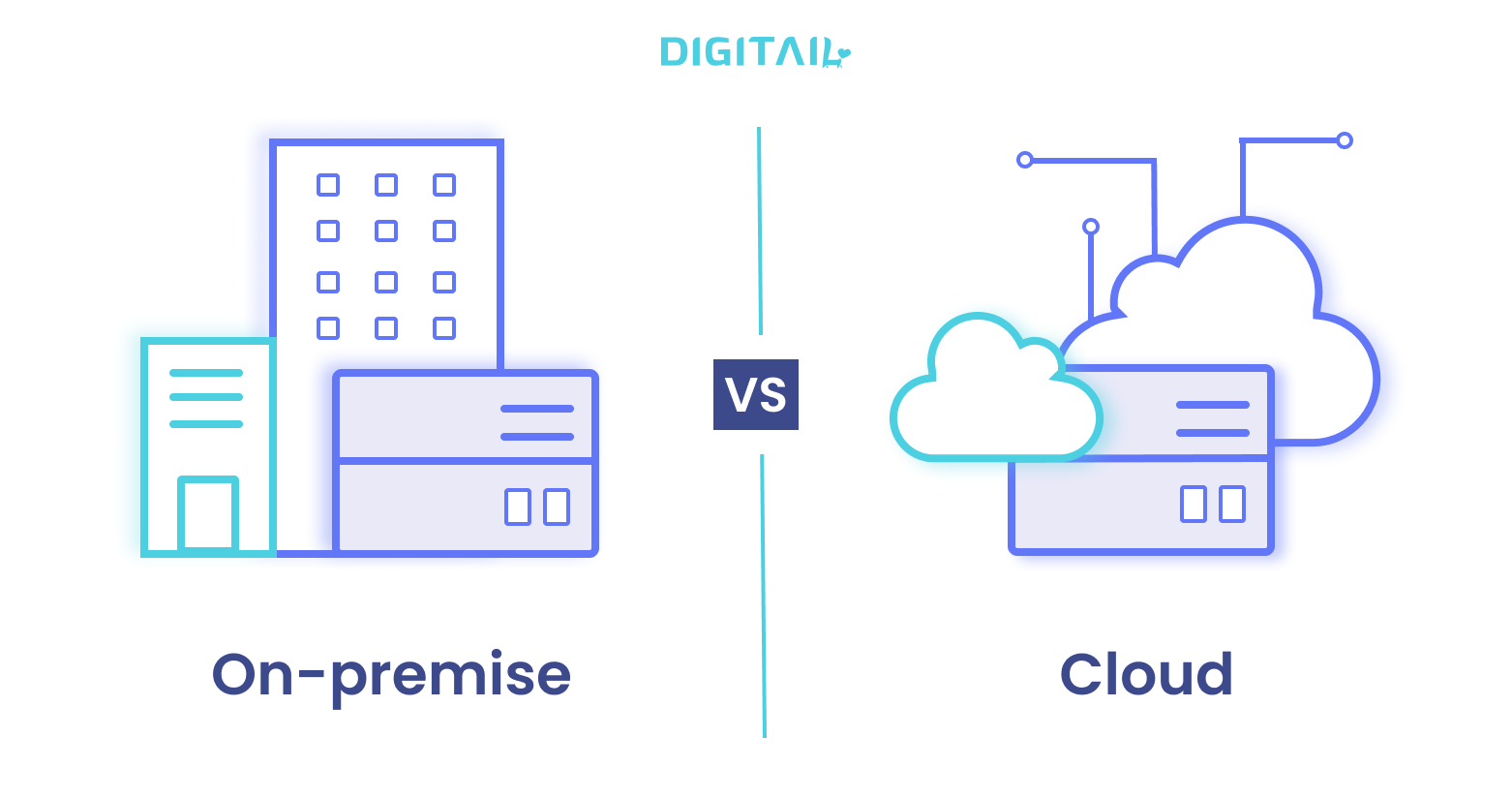
While both solutions aim to streamline veterinary practice management, their underlying technology fundamentally shapes how they perform across critical operational areas. Let’s examine how these differences impact day-to-day practice functionality.
1. Cost Effectiveness
Cloud:
- Lower Initial Investment
No need for expensive servers, networking gear, or infrastructure software.
- Predictable Monthly Costs
The subscription model spreads expenses over time, converting a large capital expenditure into a predictable operating expense. With multiple plan options, you pay only for the features you need, scaling up or down as your practice grows.
- No Maintenance Fees
The provider handles infrastructure maintenance, security updates, backups, and system upgrades, eliminating surprise IT expenses and consultant fees.
Server:
- High Upfront Costs
Requires significant investment in hardware (servers, backup solutions, networking equipment), software licenses, and a professional IT setup.
- Ongoing IT Expenses
Maintenance includes regular hardware replacements (every 3-5 years), IT support, software update fees, backup systems, power, cooling, and physical space requirements. These hidden costs add up quickly.
2. Access to Software and Data
Cloud:
- Access From Any Device
Securely log in from any internet-connected device, whether at the clinic, home, or on the go. This enables remote review of patient information, lab results, and imaging, as well as administrative management of scheduling and billing from multiple locations. For some practices, the ability to work from home is a major benefit; for others, it raises concerns about access control and data security. Solutions like Okta can help manage secure, role-based access and authentication.
- Benefits for After-Hours Care And Emergency Situations
Emergency consultations become more efficient when veterinarians can instantly access patient history and treatment plans remotely, improving response times and patient outcomes.
- Mobile-Friendly Experience
Most cloud-based veterinary software is optimized for tablets and smartphones, enabling efficient on-the-go practice management.
Server:
- Slower Remote Functionality
On-premise solutions typically provide mobile access through virtual private networks (VPNs) or remote desktop solutions, which often deliver a compromised user experience with slower performance and interface limitations.
- Offline Access Advantages
Mobile veterinary practices may face challenges with connectivity and synchronization when working in areas with limited internet access, though some server solutions offer offline functionality that cloud systems can’t match.
3. Data Security
Cloud:
- Enterprise-Grade Security
Cloud software providers invest heavily in security measures such as encryption, multi-factor authentication, and intrusion detection systems.
- Automatic Backups
Protects against data loss from hardware failure or cyberattacks.
- Disaster Recovery
Data is securely stored across multiple locations to prevent permanent loss.
- Compliance With Data Regulations
Reputable cloud-based providers ensure compliance with data regulations, such as GDPR, offering peace of mind for veterinary practices handling sensitive client and patient data.
Server:
- In-House Reliance
Server-based systems require manual backups. If backups fail or servers crash, critical data may be lost.
- Protection Limitations
Server solutions typically provide security through controlled physical access and internal network protection. However, they often face challenges with irregular security updates and patches, which can leave systems vulnerable.
- Expertise Requirements
Many practices lack specialized security expertise to implement comprehensive protection measures against modern cyber threats
4. Maintenance and Updates
Cloud:
- Automatic Updates
New features and security patches deploy without downtime. These automatic updates require no practice intervention, make new features immediately available to all users, and ensure prompt application of bug fixes and security patches. Be sure to ask your provider about server uptime and reliability—consistent access to your system is essential for daily operations.
- Resource Efficiency
Technical maintenance is handled by the provider, freeing practice staff to focus on patient care rather than IT concerns.
- Server Reliability
While cloud solutions offer many benefits, it’s important to ask providers about server uptime and reliability. Consistent system availability is critical for daily operations, so understanding service level agreements (SLAs) and support protocols can help ensure your practice isn’t caught off guard by unexpected downtime.
Server:
- Manual Upgrades
IT intervention is required for updates, sometimes causing workflow disruptions. Practices must schedule downtime for system updates, which may be delayed due to time constraints.
- Technical Complexity
Update processes can be complex, requiring technical expertise, and may introduce compatibility issues with workstations or other integrated systems.
5. Integration Capabilities
Cloud:
- Extensive Ecosystem
Cloud-based systems often integrate with a wide range of complementary services like online booking systems, telehealth platforms, inventory management tools, and marketing systems.
- API Accessibility
Most cloud solutions offer application programming interfaces (APIs) that enable connections with third-party services, allowing practices to create customized workflows that suit their unique operational needs.
Server:
Integration Limitations
Server-based systems typically offer fewer built-in integrations than their cloud counterparts, often requiring custom development for connections to newer technologies.
- Local Hardware Advantage
On-premise solutions may provide stronger integration with local hardware like specialized laboratory equipment, digital radiography systems, and practice-specific customizations already in place.
6. User Experience
Cloud:
- Intuitive Interfaces
Cloud systems typically offer modern, user-friendly interfaces that are regularly updated with the latest design standards. These interfaces are consistent across devices, allowing staff to use the same familiar system whether on clinic computers, tablets for exam rooms, or smartphones for after-hours checks.
- Simplified Onboarding
Cloud systems’ intuitive interfaces typically reduce training time for new hires. Some of the cloud PIMS offer comprehensive online training resources, including video tutorials, webinars, and searchable knowledge bases that staff can access at their own pace.
- Supported Data Migration
Providers typically assist with data migration through comprehensive programs that include data mapping and validation, phased implementation plans, and parallel running periods to ensure system reliability.
- AI-Powered Tools
Digitail has built-in AI assistant for tasks like automated lab result interpretation, smart appointment scheduling, voice-to-text feature, medical record analysis, prescription error detection, and more. Practices around the world are already seeing major time savings and improved workflows. For example, Paumanok Veterinary Hospital was able to reclaim 50 hours a week by leveraging AI-powered tools integrated into their cloud-based system.
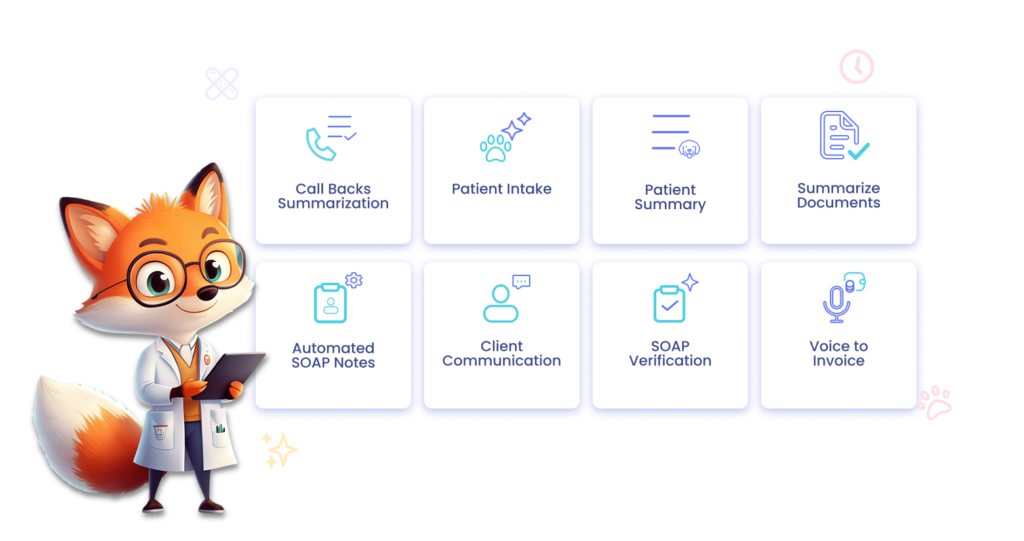
Server:
- Variable User Experience
Server-based systems often feature older interface designs that may feel dated or cumbersome compared to modern applications. While stable, these interfaces typically receive fewer updates to their user experience.
- Consistency Challenges
Remote access interfaces often differ significantly from in-clinic versions, creating learning hurdles for staff who must master multiple interfaces for the same system. Multi-location functionality can also be a challenge—sharing a system across clinics may require expensive duplicate servers or relying on slower remote access to a single server at another site.
- Complex Migration Requirements
Transitioning between server-based systems typically requires significant IT involvement, extended downtime during cutover periods, manual data transfer and validation processes, and temporary workflow disruptions. Migration may necessitate additional network infrastructure to accommodate system requirements, adding complexity and cost to the transition.
- Limited AI Implementation
Server solutions typically lag in AI implementation due to the processing power required and the complexity of deploying these features across distributed systems, with new capabilities arriving via major version updates that many practices delay implementing.
7. Customer Experience
Cloud:
- Comprehensive Client Portals
Modern cloud platforms offer feature-rich client portals enabling 24/7 access to patient records, secure two-way messaging, medication refill requests, and photo/video sharing for monitoring.
- Communication Automation
Cloud PIMS often includes appointment reminders and follow-up communications that improve client compliance and practice efficiency.
- Satisfaction Monitoring
Cloud solutions usually integrate tools for collecting and analyzing client feedback, helping practices identify improvement opportunities.
Server:
- Limited Client-Facing Features
Server-based systems typically offer more basic client portals with limited functionality. often requiring third-party integrations that create additional costs and potential points of failure.
8. Scalability for Growing Practices
Cloud:
- Frictionless Expansion
Cloud-based systems accommodate growth without significant infrastructure changes. New users can be added within minutes, additional practice locations integrate seamlessly with existing data, and capacity adjusts automatically during peak periods.
Server:
- Hardware Constraints
Server-based software typically require hardware evaluation and potential upgrades when adding users or locations, creating bottlenecks in practice expansion.
With so many critical factors to consider, how do these two options truly compare side by side?
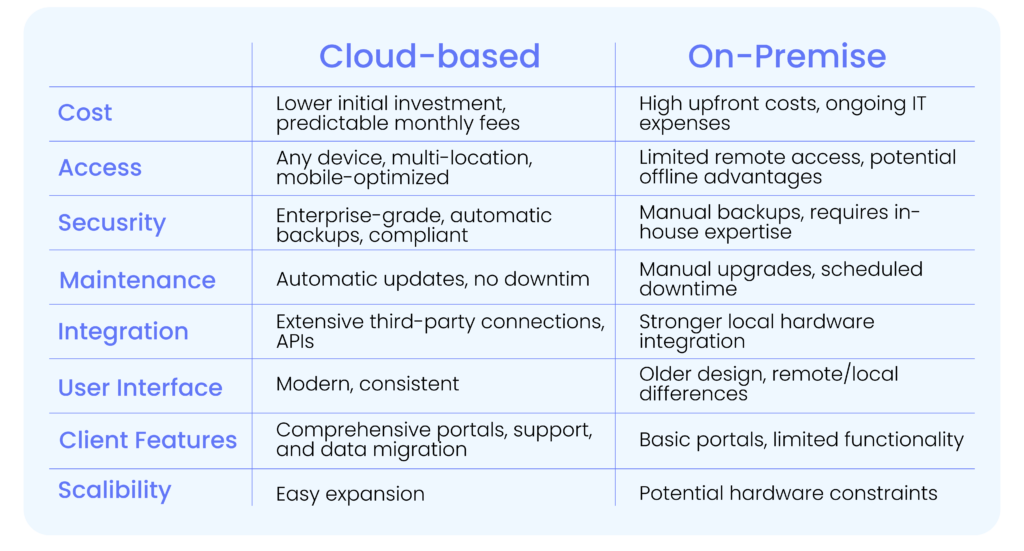
How do I choose the best PIMS for my veterinary practice?
Ultimately, electing the right PIMS is not a one-size-fits-all decision. While the industry trend clearly favors cloud-based solutions, each practice has unique requirements, goals, and operational priorities that should guide this important decision.
Consider a cloud-based solution if:
- You value mobility and need to access patient information from multiple locations or devices
- Your practice is growing, or plans to expand to multiple locations
- You prefer predictable monthly costs over large upfront investments
- Your team lacks dedicated IT resources for system maintenance
- Client engagement and modern communication tools are priorities
- Your practice emphasizes efficiency through automation and AI integration
- You value simplicity, comprehensiveness, and prefer avoiding third-party integrations
- You want to offer a modern, seamless client experience
A server-based solution might be more suitable if:
- Your practice operates in an area with consistently unreliable internet connectivity
- You have substantial investments in specialized hardware that integrates better with on-premise systems
- You have specific regulatory or compliance requirements that necessitate complete data control
- Your practice already employs dedicated IT staff experienced with server maintenance
If you’re leaning toward a cloud-based system but want to see it in action before making a decision, we can help. Digitail is an all-in-one cloud veterinary PIMS that is designed to streamline operations, improve efficiency, save time for veterinary teams, and enhance patient care.
Ready to See How a Cloud-Based PIMS Can Work for You?
Explore the benefits firsthand and discover how Digitail can support your practice.
Frequently Asked Questions
Cloud-based software runs on remote servers, which are accessed via the internet with automatic updates.
Server-based is installed locally on practice hardware, requiring manual maintenance.
Cloud-based is typically more cost-effective due to lower upfront costs and no IT maintenance fees.
Yes, leading cloud PIMS implement robust security measures, including data encryption, multi-factor authentication, continuous security monitoring, and compliance with healthcare data regulations.
While any practice management system transition requires planning and adjustment, modern veterinary PIMS like Digitail offer seamless migration support, ensuring a smooth transition with minimal downtime.
For a step-by-step overview of the process, read our guide: The Digitail Data Migration Experience.
